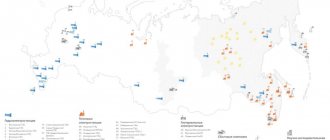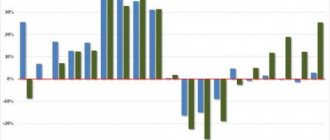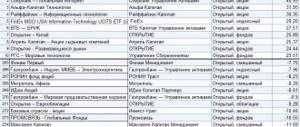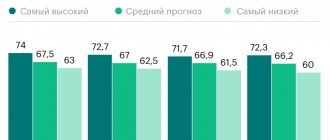| Order form |
| If you have questions about this work or want to study the DEMO version (if it is not on the site), or require similar work for another company (bank) , or for another period (as reports are released), write a message to the author . |
Download demo version (IFRS, 2018-2020)
Download demo version (RAS, 2018-2020)
Download demo version (IFRS, 2017-2019)
Download demo version (RAS, 2017-2019)
Download demo version (IFRS, 2016-2018)
Download demo version (RAS, 2016-2018)
The content of the work
General characteristics of PJSC "Magnit"
Public Joint Stock Company "Magnit" (PJSC "Magnit") is the holding company of the Group, engaged in retail trade through the chain of stores "Magnit", with its location in Krasnodar. Currently, the Magnit chain of stores is the largest food retail chain in Russia. About two-thirds of Magnit PJSC stores operate in cities with a population of less than 500 thousand people. Most of the Group's stores are located in the Southern, Central and Volga regions. Magnit chain stores are also located in the North-Western, North Caucasus, Ural and Siberian Federal Districts.
The mission of PJSC “Magnit” is formulated as follows: “We work to improve the well-being of our customers by reducing their costs for the purchase of quality consumer goods, taking care of the company’s resources, improving technology and adequately rewarding employees.”
Within the framework of the medium-term development prospects of PJSC "Magnit", the following priority areas of development can be named:
- Further expansion of the network due to increased coverage density in key markets of presence, as well as organic development in the least developed regions of Russia.
- Development of a multi-format business model: continuation of the aggressive development of the “convenience store”, “hypermarket”, “Family Magnit” and “drogerie” formats.
- Formation of a high level of brand loyalty on the part of key audiences.
- Implementation of additional measures to optimize costs and improve profitability.
- Network development. In the next 2-3 years, PJSC Magnit plans to maintain high business growth rates. Thus, for 2021, it is planned to open 900-950 convenience stores, 80 hypermarkets (including Magnit Family stores), as well as 1,200 drogerie stores. The company's accumulated experience and technologies allow it to open profitable small-format stores in settlements with a population of only 5,000 people, while for hypermarket and Magnit Family format stores this threshold is only 25,000 people.
- Development of multi-format. Currently, PJSC “Magnit” is actively developing four formats: “convenience store”, “hypermarket”, “Family Magnit” and “drogerie store”. The “convenience store” format is a convenience store aimed at all customers living within a radius of 500 meters. The assortment of the convenience store includes more than 3,700 essential food and non-food products sold at affordable prices. The average total store area is 455 square meters. m., average retail space – 325 sq. m. As of December 31, 2015, the Magnit retail chain has 9,594 convenience stores, 1,250 of which were opened in 2015.
Section 1. General characteristics of the company’s balance sheet indicators
Table 1 – Analysis of intra-balance sheet relationships
Section 2. Horizontal analysis of the balance sheet
Table 2 - Horizontal analysis of the balance sheet of PJSC "Magnit"
Figure 1 - Dynamics of the value of non-current and current assets of PJSC "Magnit" for 2018-2020.
Figure 2 - Dynamics of equity and borrowed capital of PJSC "Magnit" for 2018-2020.
Section 3. Vertical analysis of the balance sheet
Table 3 – Vertical analysis of the balance sheet of PJSC "Magnit"
Figure 3 – Structure of assets of PJSC “Magnit” for 2018-2020 (%)
Figure 4 – Structure of sources of property of PJSC “Magnit” for 2018-2020. (%)
Section 4. Analysis of balance sheet liquidity
Table 4 – Analysis of liquidity of the balance sheet of PJSC “Magnit”
Figure 5 - The ratio of the most liquid assets and the most urgent liabilities of PJSC "Magnit" for 2018-2020.
Figure 6 – The ratio of quickly realizable assets and short-term liabilities of PJSC “Magnit” for 2018-2020.
Figure 7 – Ratio of slowly selling assets and long-term liabilities of PJSC “Magnit” for 2018-2020.
Figure 8 – The ratio of hard-to-sell assets and permanent liabilities of PJSC “Magnit” for 2018-2020.
Section 5. Analysis of the company's solvency
Table 5 - Analysis of solvency indicators of PJSC "Magnit"
Figure 9 – Dynamics of the absolute liquidity ratio of PJSC “Magnit” for 2018-2020.
Figure 10 – Dynamics of the critical (interim) liquidity ratio of PJSC “Magnit” for 2018-2020.
Figure 11 – Dynamics of the current liquidity ratio of PJSC “Magnit” for 2018-2020.
Figure 12 – Dynamics of the total liquidity ratio of PJSC “Magnit” for 2018-2020.
Section 6. Analysis of the financial stability of the company
Table 6 - Analysis of the financial stability of PJSC "Magnit" using absolute indicators
Table 7 - Analysis of the financial stability of PJSC "Magnit" using relative indicators
Table 8 - Calculation of the value of the company's net assets
Figure 13 – Dynamics of the autonomy coefficient of PJSC “Magnit”
Section 7. Analysis of financial results
Table 9 – Analysis of financial results of PJSC “Magnit”
Figure 14 – Dynamics of gross financial result and financial result from sales of PJSC “Magnit” for 2018-2020.
Figure 15 – Dynamics of the financial result before tax and the net financial result of PJSC “Magnit” for 2018-2020.
Table 10 – Checking compliance with the criteria of the “golden rule of economics”
Section 8. Analysis of the company's business activity
Table 11 – Indicators of business activity of PJSC “Magnit”
Section 9. Analysis of the profitability of the company
Table 12 - Analysis of profitability indicators of PJSC "Magnit"
Table 13 – Analysis of return on equity using the DuPont model
Table 14 – Effect of financial leverage of PJSC “Magnit” according to the European model
Section 10. Analysis of the satisfaction of the balance sheet structure
Table 15 – Assessment of the current solvency of PJSC “Magnit”
Table 16 – Assessment of the satisfactory structure of the balance sheet of PJSC “Magnit”
Section 11. Analysis of the probability of bankruptcy using foreign models
Table 17 - Assessment of the probability of bankruptcy of PJSC "Magnit" using the two-factor Altman model
Table 18 - Assessment of the probability of bankruptcy of PJSC "Magnit" using Altman's five-factor model of 1968
Table 19 - Assessment of the probability of bankruptcy of PJSC "Magnit" using Altman's five-factor model 1983
Table 20 - Assessment of the probability of bankruptcy of PJSC "Magnit" using the Liss model
Table 21 – Estimation of the probability of bankruptcy using the Taffler model
Table 22 - Assessment of the probability of bankruptcy of PJSC "Magnit" using the Springate model
Table 23 – Systematization of the results of assessing the probability of bankruptcy using foreign models
Section 12. Analysis of the probability of bankruptcy using domestic models
Table 24 – Assessment of the probability of bankruptcy of PJSC "Magnit" using the Russian (Irkutsk) R-model
Table 25 – Assessment of the probability of bankruptcy of PJSC “Magnit” using the O.P. model. Zaitseva
Table 26 – Assessment of the probability of bankruptcy of PJSC "Magnit" using the model of R.S. Saifullin and G.G. Kadykova
Table 27 - Grouping of indicators - criteria for assessing financial condition according to the method of L.V. Dontsova and N.A. Nikiforova
Table 28 – Assessment of the financial condition of PJSC “Magnit” using the model of L.V. Dontsova and N.A. Nikiforova
Table 29 – Model G.V. Savitskaya
Table 30 – Assessment of the financial condition of PJSC “Magnit” using the model of G.V. Savitskaya
Table 31 – Assessment of the financial condition of PJSC “Magnit” using the M.A. model. Fedotova
Table 32 – Systematization of the results of assessing the probability of bankruptcy using domestic models
conclusions
- 1. Characterizing the state of liquidity, we can conclude that during the analyzed period the company’s balance sheet remained predominantly liquid. At the same time, the dynamics of the balance sheet liquidity state were predominantly positive.
- 2. At the end of the analyzed period, the company was experiencing problems with ensuring solvency.
- 3. According to the criterion of having equity capital, the company remained financially stable throughout the analyzed period.
- 4. PJSC "Magnit" worked, receiving a positive net financial result.
- 5. The company's business activity increased as its assets, capital and liabilities began to make more turnover during the analyzed period.
- 6. The company’s operating efficiency decreased, since each ruble invested in assets began to bring in less profit during the analyzed period.
A different situation three days ago and today!
Despite the fact that Magnit is actively promoting quality, convenience and “light” price tags, I think that in addition to loud slogans there should be real action.
Today I returned, was nearby and came in, not giving up hope of still buying this unfortunate jar. And what do you think? No! Nothing happened. Once again I was disappointed at the checkout. After 15 minutes of waiting for the goods to get into the database, I again left with nothing. True, today I also found an overdue one there, by accident.
“Magnit” decided to rename itself, well, again some kind of marketing strategy. Useless, in the absence of order in all of the above. Now large stores of this chain will be called “Magnit Extra”. But I would give all the stores in this chain a new name: “Grey Mouse”. It’s clear and understandable why.
The situation was different three days ago and today.
Why is the Magnit supermarket so dirty? Why do buyers more often choose Pyaterochka, despite the fact that, for example, the sellers of the nickel themselves shop at Magnit? And how did the change of the main owner of the network, Sergei Galitsky, in my opinion, literally destroy the network?
§ Magnit Number of Stores in Russia 2021 If at Pyaterochka, under equal conditions, the cashier returns the money through the cash register, takes the check from me and issues another with the corrected amount. Here they left me a check, and gave me the money from the cashier’s wallet. Oh, how! Then it became clear why the sellers were so sad. But, on the other hand: if you don’t like it, don’t work. Number of Magnets in Russia 2021











